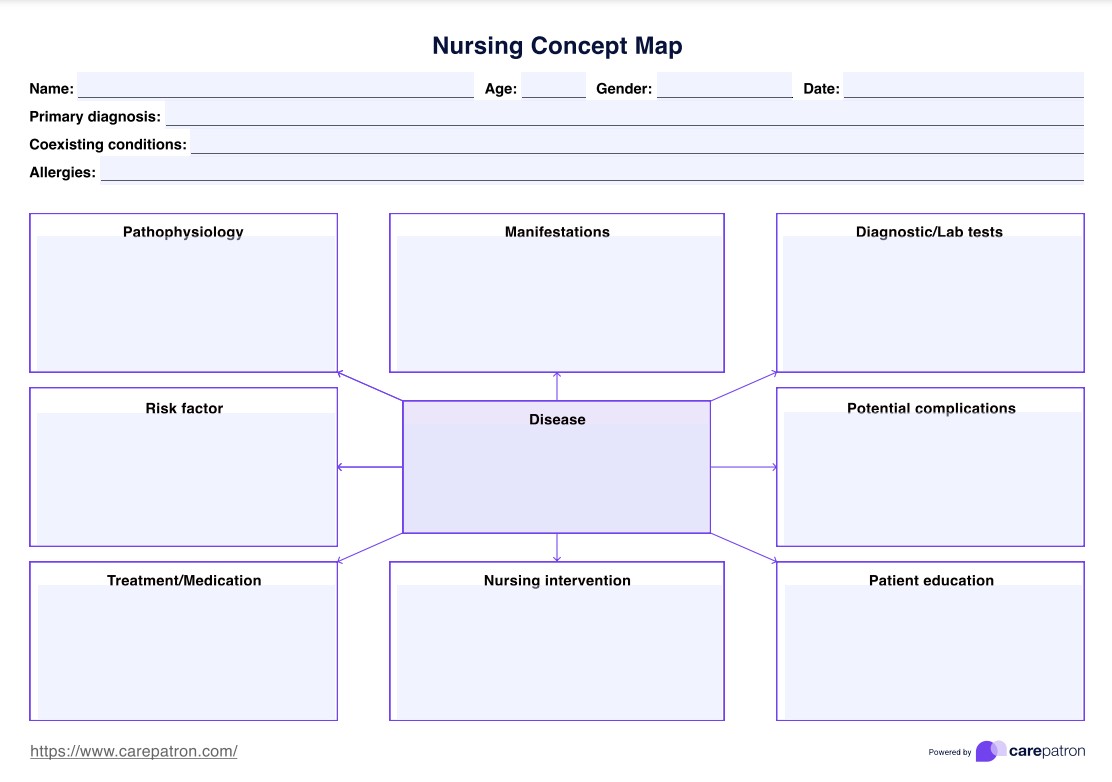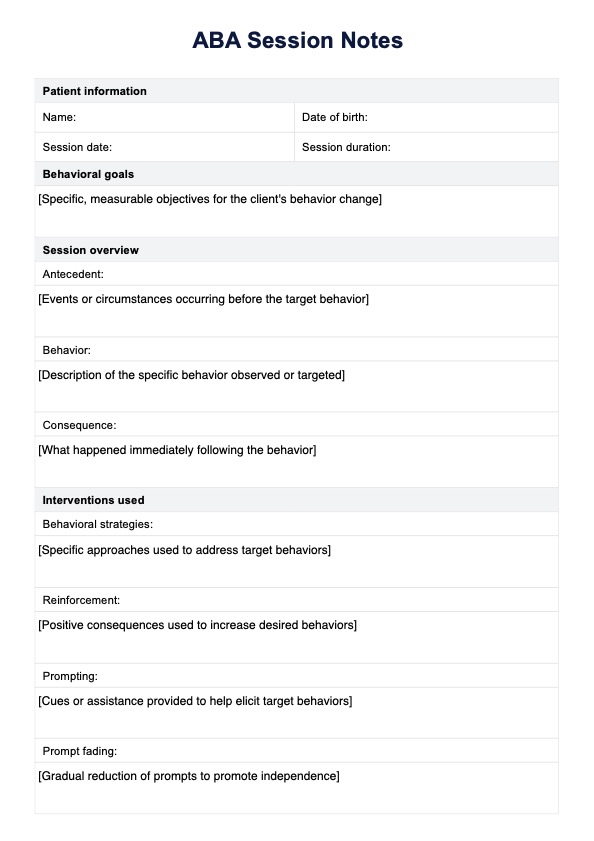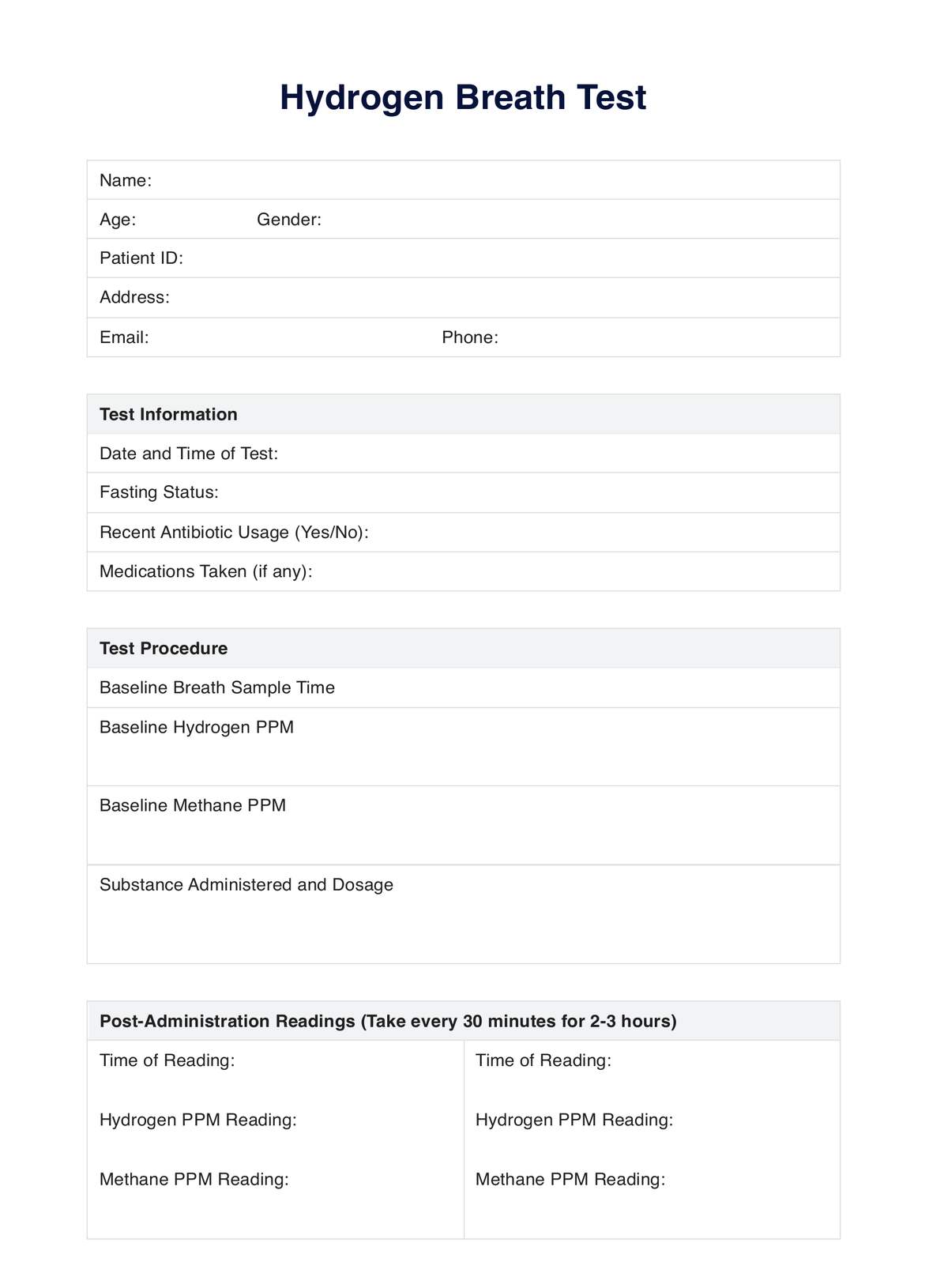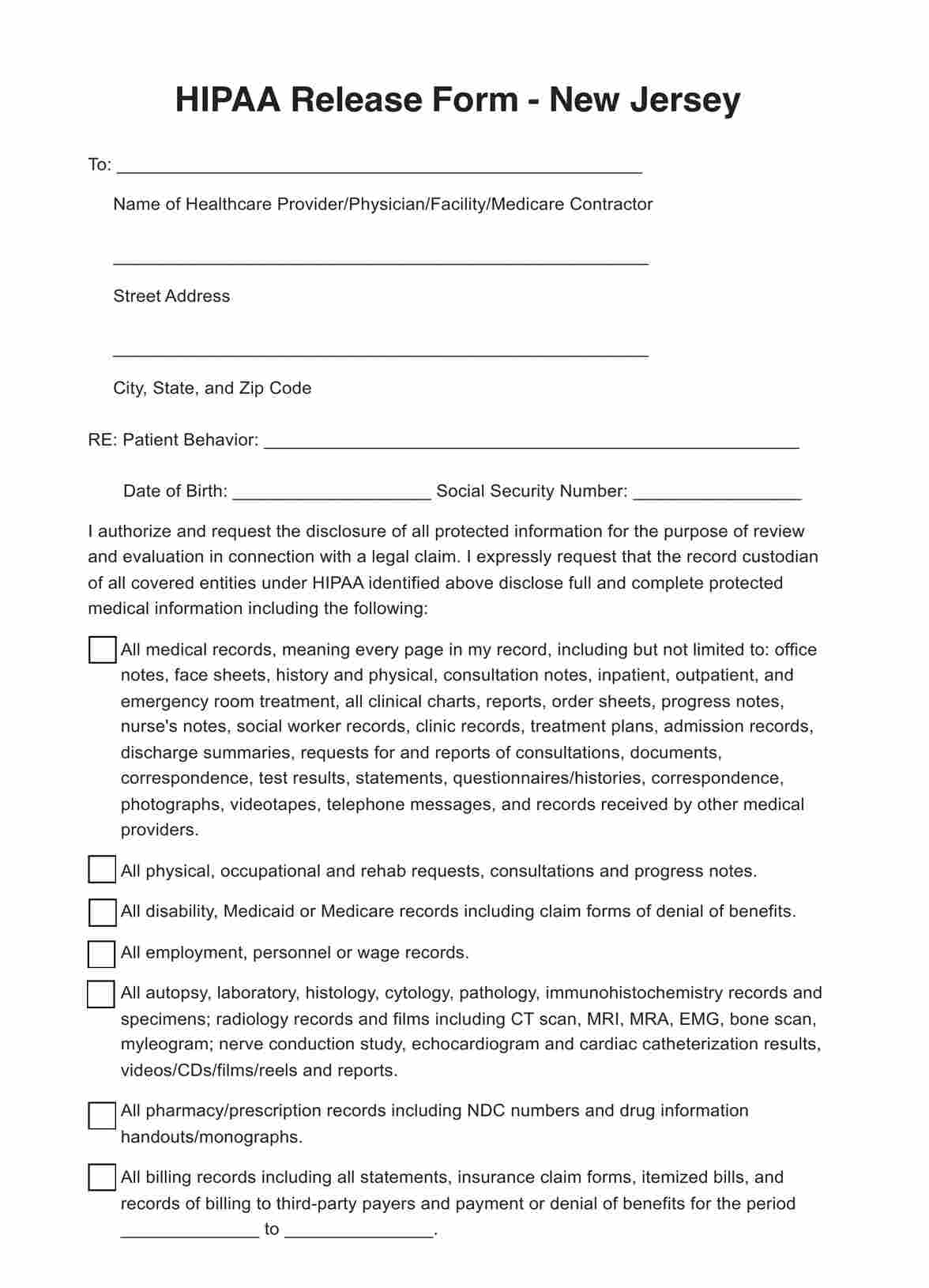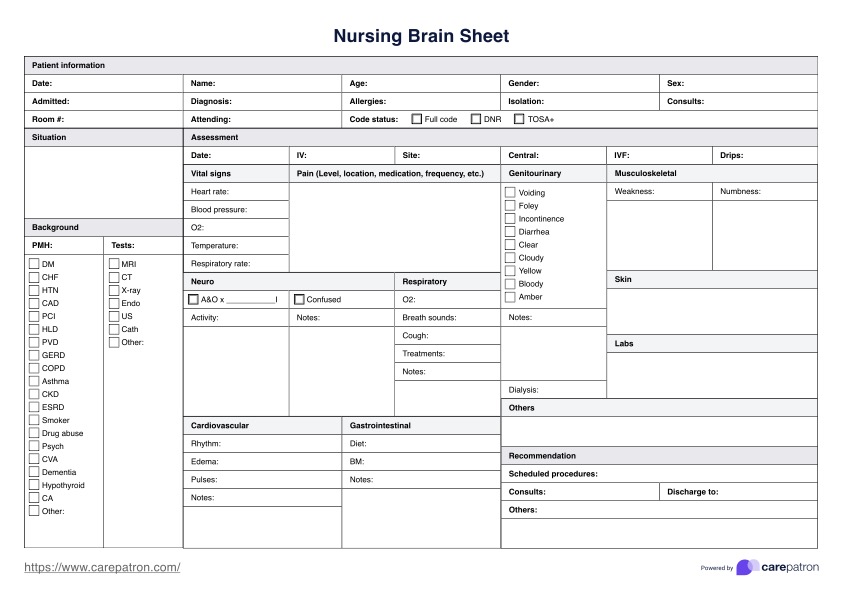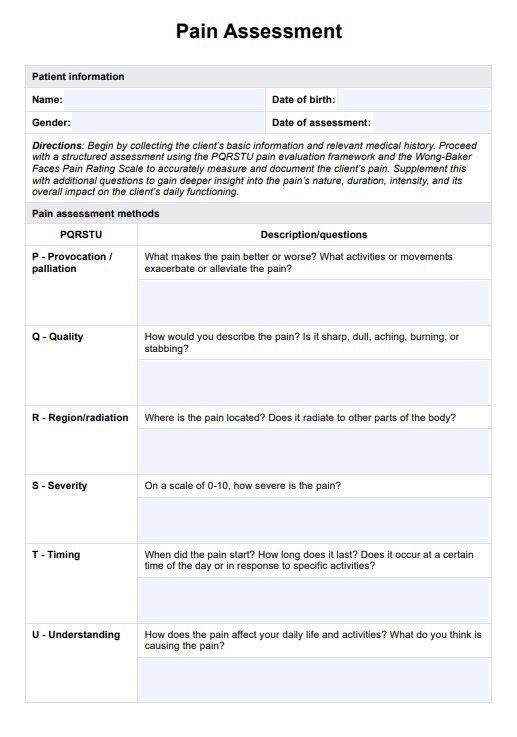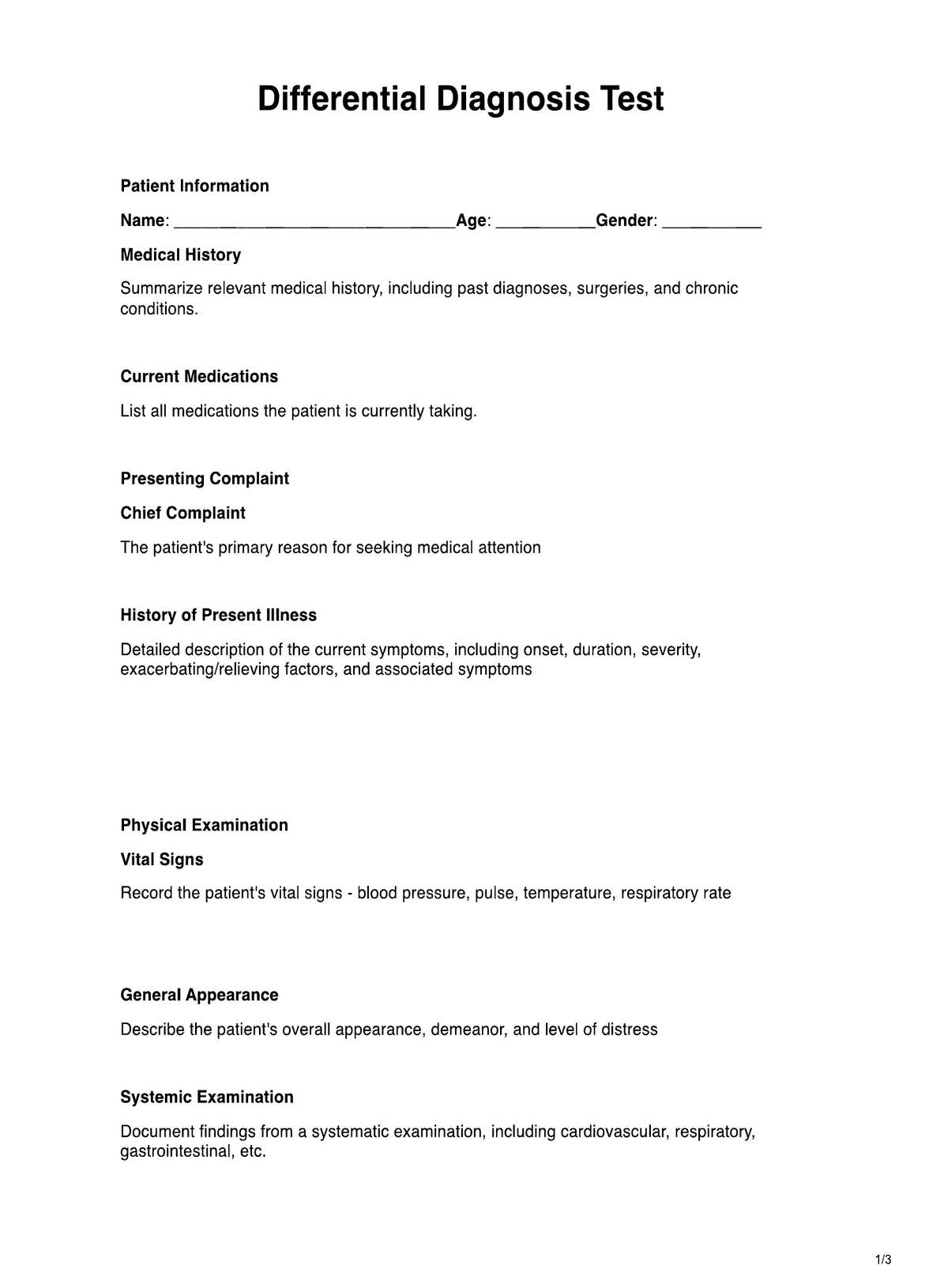Fatigue Assessment
Improve workplace safety and employee well-being with this valuable resource. Download Carepatron's free PDF of a fatigue assessment tool here to assess and manage fatigue in various settings.


What is fatigue?
Fatigue is a common and often overlooked aspect of our daily lives that can significantly impact our overall well-being. In simple terms, fatigue refers to a state of extreme tiredness or exhaustion, both physically and mentally. It is not just a fleeting feeling of weariness; instead, it is a persistent and overwhelming sensation that can hinder our ability to perform daily tasks efficiently.
Physiologically, fatigue can manifest as a decline in muscular strength, reduced coordination, and slower reaction times. Mentally, it may lead to difficulties in concentration, memory lapses, and impaired decision-making. Understanding the various dimensions of chronic fatigue is crucial, as it can be influenced by factors such as inadequate sleep, excessive physical or mental exertion, stress, and certain medical conditions. If this happens, assessments like chronic fatigue syndrome tests are done by doctors.
It's important to note that fatigue is not solely synonymous with sleepiness. While insufficient sleep is a common cause of fatigue, it can also result from prolonged periods of intense mental focus, emotional stress, or physical exertion. Recognizing the nuanced nature of fatigue is essential for accurate self-assessment and effective management.
Fatigue Assessment Template
Fatigue Assessment Example
Types of fatigue
Fatigue comes in various forms, each presenting its challenges and implications for our daily lives. Understanding these different types is crucial for accurate fatigue assessment. Let's explore the key categories so individuals can know how measuring fatigue looks like.
Mental fatigue
Mental fatigue is characterized by cognitive weariness and reduced mental sharpness. This can result from prolonged intense concentration, information processing, or decision-making. It's common in occupations requiring sustained mental effort, such as knowledge work or tasks demanding creative thinking. Identifying mental fatigue is crucial for adjusting workloads and incorporating adequate breaks to maintain optimal cognitive performance.
Physical fatigue
Physical fatigue is the weariness of the body's musculoskeletal system due to prolonged physical activity or exertion. It often accompanies activities that demand repetitive movements or sustained effort. Athletes, laborers, and individuals engaging in intense physical workouts commonly experience physical fatigue. A well-rounded fatigue assessment should account for physical tiredness, allowing for adjustments in exercise routines and daily activities.
Chronic fatigue syndrome (CFS)
Chronic Fatigue Syndrome is a complex and long-term condition characterized by persistent, unexplained fatigue that doesn't improve with rest. Individuals with CFS often experience severe fatigue, along with other symptoms such as impaired concentration, sleep disturbances, and muscle pain. While the exact cause of CFS is not fully understood, recognizing its distinct nature is vital for proper management and seeking medical guidance when necessary.
Severe fatigue
Severe fatigue goes beyond the typical tiredness we experience in our daily lives. It is an intense and often debilitating form of exhaustion that can significantly impact one's ability to perform routine tasks. Identifying severe fatigue is crucial for implementing targeted interventions and lifestyle adjustments to mitigate its effects.
Extreme fatigue
Extreme fatigue surpasses the ordinary tiredness associated with daily activities. It is an intense and overwhelming sensation of exhaustion that can affect both physical and mental capacities. Individuals experiencing extreme fatigue may find it challenging to engage in normal daily functions. Recognizing and addressing extreme fatigue is vital for maintaining overall well-being and preventing burnout.
What is the Fatigue Assessment scale?
The Fatigue Assessment Scale (FAS) comprises 10 items to assess chronic fatigue symptoms. Unlike alternative assessments like the Multidimensional Fatigue Inventory, the FAS adopts a singular approach to fatigue evaluation, refraining from dividing it into various factors.
Nevertheless, developers ensured comprehensive coverage of fatigue facets by selecting items reflecting both physical and mental symptoms.
Key elements in the fatigue assessment scale include:
CIS
The Checklist Individual Strength (CIS) is a commonly used self-report questionnaire designed to assess subjective fatigue. It consists of items that inquire about various aspects of fatigue, including physical and mental fatigue, reduced motivation, and reduced activity levels. CIS is frequently used in clinical settings, research studies, and occupational health assessments to evaluate fatigue severity and its impact on daily functioning.
WHOQOL
The World Health Organization Quality of Life (WHOQOL) assessment is a standardized instrument developed by the World Health Organization to measure subjective quality of life across physical, psychological, social, and environmental domains. While not specifically designed to assess fatigue, WHOQOL includes items related to energy levels, vitality, and overall well-being, which can indirectly reflect aspects of fatigue and its impact on quality of life.
FS
The Fatigue Scale (FS) is a tool used to measure and assess fatigue levels in individuals. It typically consists of a series of items or statements related to fatigue symptoms, which respondents rate based on their frequency or severity. FS may be used in clinical practice, research studies, or occupational health assessments to quantify fatigue symptoms and monitor changes over time. Different versions of fatigue scales exist, tailored for specific populations or purposes.
When to use the Fatigue Assessment scale?
The Fatigue Assessment Scale (FAS) is typically utilized in clinical settings and research studies to evaluate symptoms of chronic fatigue. It serves as a tool for healthcare professionals to assess the severity and impact of fatigue experienced by individuals.
Additionally, the FAS can be employed in various contexts such as monitoring fatigue levels in patients with chronic illnesses, assessing treatment effectiveness, and understanding the overall burden of fatigue on an individual's well-being.
Clinical assessment
The FAS is frequently employed by healthcare professionals as a clinical tool to assess the severity and impact of chronic fatigue in patients. It helps in diagnosing conditions such as chronic fatigue syndrome, fibromyalgia, and other illnesses characterized by persistent fatigue.
Research studies
In research settings, the FAS is utilized to measure and quantify fatigue levels in study participants. Researchers use it to investigate the associations between fatigue and various factors such as medical conditions, treatments, lifestyle factors, and psychological variables.
Treatment monitoring
Healthcare providers often use the FAS to monitor changes in fatigue levels over time in response to treatment interventions. By regularly administering the scale, clinicians can assess the effectiveness of treatments and make adjustments as necessary to improve patients' quality of life.
Occupational health
In occupational health settings, the FAS may be employed to evaluate fatigue levels among workers in industries where fatigue-related issues pose risks, such as transportation, healthcare, and shift work. Assessing fatigue helps organizations implement strategies to manage fatigue-related risks and improve workplace safety.
Sports and performance
Coaches, trainers, and athletes may use the FAS to monitor fatigue levels during training and competitions. By tracking fatigue, they can optimize training regimens, prevent overtraining, and enhance performance outcomes.
Fatigue management programs
Fatigue management programs in various settings, such as workplaces and healthcare facilities, may incorporate the FAS as part of their assessment protocols. By identifying individuals with high levels of fatigue, these programs can tailor interventions to support fatigue management and promote overall well-being.
Scoring and result interpretation
The Fatigue Assessment (FAS) tool utilizes a five-point Likert-type scale ranging from 1 (“never”) to 5 (“always”) to assess fatigue levels. Items 4 and 10 are reverse-scored, meaning that higher scores on these items indicate lower fatigue levels. The total score on the FAS can range from 10 to 50, with higher scores indicating higher fatigue levels.
Total scores closer to 10 indicate lower levels of fatigue, with respondents rarely experiencing fatigue symptoms. Meanwhile, total scores closer to 50 suggest higher levels of fatigue, with respondents experiencing fatigue symptoms frequently or almost always. Lastly, intermediate scores between 10 and 50 reflect varying degrees of fatigue severity, with higher scores indicating more significant fatigue.
Next steps
Completing a fatigue assessment is a valuable first step toward understanding and managing your energy levels. After assessing your fatigue levels, consider the following next steps to enhance your overall well-being:
Create a personalized action plan
Based on your fatigue assessment results, develop a personalized action plan. Identify specific areas that require attention, whether they relate to sleep, stress management, physical activity, or other lifestyle factors. Your action plan should be realistic, achievable, and tailored to your unique needs, setting the foundation for sustainable improvements in energy levels.
Explore lifestyle modifications
Consider making gradual lifestyle modifications to address identified areas of concern. This could involve adjusting sleep routines, incorporating regular physical activity, practicing stress-reduction techniques, or fine-tuning your work-life balance. Small, consistent changes can have a significant impact on overall fatigue levels over time.
Consult with healthcare professionals
If persistent or severe fatigue persists, it's advisable to consult with healthcare professionals. Chronic fatigue may be indicative of underlying health conditions that require specialized attention. Medical professionals can conduct additional tests, review your symptoms, and provide tailored recommendations for managing and improving your energy levels.
Tests to assess fatigue
In addition to self-assessment tools, healthcare professionals may employ various tests to assess fatigue, including:
- Blood tests: Blood tests can identify potential nutritional deficiencies, hormonal imbalances, or underlying medical conditions contributing to fatigue.
- Sleep studies: For individuals experiencing sleep-related fatigue, a sleep study can provide insights into sleep disorders and patterns, guiding targeted interventions.
- Psychological assessments: Mental health assessments may be conducted to explore the impact of stress, anxiety, or depression on overall fatigue levels.
- Physical fitness assessments: Evaluating physical fitness, endurance, and muscle strength can offer insights into the contribution of physical fatigue to overall tiredness.
Note: If possible, please include the other tests to assess fatigue.
Commonly asked questions
The best scale to assess fatigue depends on individual preferences and context. Commonly used scales include the Fatigue Severity Scale (FSS), the Chalder Fatigue Scale, and the Brief Fatigue Inventory. Choose a scale that aligns with your needs, considering factors like the level of detail required and ease of use.
The 10-Item Fatigue Assessment Scale, also known as the FAS-10, is a self-report questionnaire designed to measure fatigue levels. It comprises ten items assessing the impact of fatigue on various aspects of daily life. Users rate each item on a scale, quantitatively measuring fatigue severity.
While both scales measure fatigue, the main difference lies in their focus and structure. The Fatigue Assessment Scale typically assesses the impact of fatigue on daily functioning through various aspects, while the Fatigue Severity Scale measures explicitly the severity of fatigue symptoms. Choosing between them depends on your specific goals and the depth of assessment required.








































































































